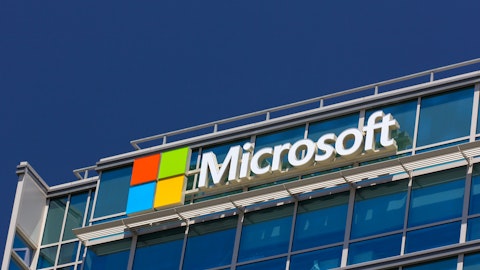In this article, we will take a look at the 9 Best Long-Term Stocks to Buy According to D. E. Shaw.
David E. Shaw, a Stanford University alumnus, is among of the hedge fund managers who have mastered the complexities of quant trading and routinely generating significant returns. Shaw’s two main funds, Composite and Oculus, under the D.E. Shaw hedge fund, have continuously produced an average net return of 12% through a quantitative investment strategy.
2025 is also shaping up to be an eventful year for the hedge fund, as D.E. Shaw sought to raise $5 billion for the launch of its Cogence Fund, which would be its inaugural multi-strategy hedge fund managed only by human traders as opposed to computer algorithms. Cogence, which was scheduled to begin trading on October 1, will use fundamental analysis to find global opportunities in credit and stocks, enabling traders to make snap decisions about timing, pricing, and risk.
The launch comes at a time when many major hedge funds remain closed to outside investors, leaving traders looking for substantial discretionary mandates with few options. This applies to D.E. Shaw as well: over the last decade, Shaw’s Composite Fund and the macro-focused Oculus Fund have both mainly remained closed.

David E. Shaw of D.E. Shaw
Our Methodology
For this list, we picked stocks from D. E. Shaw’s 13F portfolio as of the end of the second quarter of 2025. These equities have been a part of the hedge fund manager’s portfolio for at least 5 years.
We have added the performance of each stock from the end of Q2 2025 to November 11, providing readers with insight into how D.E. Shaw’s portfolio picks have played out so far.
Why are we interested in the stocks that hedge funds pile into? The reason is simple: our research has shown that we can outperform the market by imitating the top stock picks of the best hedge funds. Our quarterly newsletter’s strategy selects 14 small-cap and large-cap stocks every quarter and has returned 427.7% since May 2014, beating its benchmark by 264 percentage points (see more details here).
9. Boston Scientific Corporation (NYSE:BSX)
Share Price Return Between July 1 and November 11: -2.18%
D.E. Shaw’s Q2 Stake Value: $725.5 million
Number of Hedge Fund Holders: 100
Boston Scientific Corporation (NYSE:BSX) ranks among the best long-term stocks to buy according to D. E. Shaw. On October 23, UBS maintained its Buy rating on Boston Scientific Corporation (NYSE:BSX) shares, and increased its price target to $140 from $135. The price target raise comes after Boston Scientific’s quarterly results, which showed organic sales and earnings per share growth that surpassed both UBS and consensus expectations, with solid revenue growth of 21.4% year-over-year.
The company generated $5,065 million in net revenue for the third quarter, representing 15.3% year-over-year organic growth. Meanwhile, it produced adjusted earnings per share of $0.75 for the quarter, substantially higher than the $0.71 consensus estimate. Following the results, Boston Scientific Corporation (NYSE:BSX) increased its full-year 2025 outlook, now anticipating roughly 20% growth and adjusted EPS of $3.02-$3.04, up from earlier estimates.
Moreover, the company’s FARAPULSE product line saw roughly 63% organic worldwide expansion, with US growth improving by 40 percentage points on a comp-adjusted basis. The product also experienced faster growth abroad, although at a slower mid-single-digit pace.
According to UBS, Boston Scientific’s WATCHMAN device experienced 35% organic sales growth for the fifth consecutive quarter, as product acceptance continues to climb.
Boston Scientific Corporation (NYSE:BSX) is a global leader in the manufacture of medical devices, including stents, brain stimulation systems, heart monitors, and catheters.
8. Booking Holdings Inc. (NASDAQ:BKNG)
Share Price Return Between July 1 and November 11: -11.87%
D.E. Shaw’s Q2 Stake Value: $799.9 million
Number of Hedge Fund Holders: 92
Booking Holdings Inc. (NASDAQ:BKNG) ranks among the best long-term stocks to buy according to D. E. Shaw. In light of Booking Holdings Inc. (NASDAQ:BKNG)’s impressive third-quarter performance, Bernstein maintained its Market Perform rating and $5,433 price target on the company’s shares on October 30. According to analyst Richard Clarke, the travel giant reported an 8% increase in room nights, 2.5% more than forecast and 2% higher than consensus projections.
The company’s adjusted EPS increased by 19%, while adjusted EBITDA rose by 15%, suggesting solid operational performance. Additionally, Booking Holdings Inc. (NASDAQ:BKNG) boosted its annual run-rate savings forecasts due to the performance of the Transformation Program.
Despite challenging European comparisons as well as tough macroeconomic environments in the United States, Booking Holdings Inc. (NASDAQ:BKNG) now projects a 10% revenue growth and high-teens EBITDA growth for the year.
Although Bernstein praised Booking’s excellent performance, the firm warned that the quarterly results might not completely resolve current discussions on AI’s potential impact on the company’s commission structure and business model.
Booking Holdings Inc. (NASDAQ:BKNG) provides online travel and related solutions, such as accommodation reservations. The company offers its services through various brands, including Booking.com, Priceline, Agoda, KAYAK, and OpenTable.
7. Merck & Co. Inc. (NYSE:MRK)
Share Price Return Between July 1 and November 11: 11.17%
D.E. Shaw’s Q2 Stake Value: $820.7 million
Number of Hedge Fund Holders: 92
Merck & Co. Inc. (NYSE:MRK) ranks among the best long-term stocks to buy according to D. E. Shaw. On October 30, Merck & Co. Inc. (NYSE:MRK) announced its Q3 2025 earnings, showing better-than-expected financial results despite uneven product portfolio performance. The company’s revenue of $17.3 billion crossed analyst estimates of $16.98 billion, while its EPS of $2.58 considerably surpassed analyst projections of $2.35.
Merck’s oncology division remains the main driver of growth, led by KEYTRUDA’s $8.1 billion in sales for the quarter. Other oncology medications also showed solid results, with WELIREG sales jumping 41% to $196 million, Lynparza sales rising 12% to $379 million, and Lenvima sales growing 2% to $258 million.
The FDA’s approval of subcutaneous pembrolizumab (KEYTRUDA QLEX) for all solid tumor indications that had previously been approved for intravenous KEYTRUDA was a major regulatory milestone during the quarter. This formulation may enhance the patient experience, given that it can be administered in as little as one minute.
That said, Merck & Co. Inc. (NYSE:MRK) saw substantial challenges in its vaccines division, as GARDASIL sales fell 25% to $1.7 billion, primarily as a result of a decline in Chinese sales.
Merck & Co. Inc. (NYSE:MRK) is a healthcare company that offers human health pharmaceuticals, veterinary pharmaceuticals, vaccines & health management solutions and services.
6. Amazon.com, Inc. (NASDAQ:AMZN)
Share Price Return Between July 1 and November 11: 12.99%
D.E. Shaw’s Q2 Stake Value: $853.9 million
Number of Hedge Fund Holders: 335
Amazon.com, Inc. (NASDAQ:AMZN) ranks among the best long-term stocks to buy according to D. E. Shaw. Benchmark reaffirmed its Buy rating on Amazon.com, Inc. (NASDAQ:AMZN) and boosted its price target from $260 to $295 on October 31. Despite continuous investment phases, the price target rise reflects rising confidence in Amazon’s growth trajectory, representing a 13.5% boost from Benchmark’s previous assessment.
According to Benchmark, Amazon’s AWS cloud segment grew by 20% in the third quarter, surpassing the firm’s forecast that it would reach this milestone in the fourth quarter.
Amazon.com, Inc. (NASDAQ:AMZN) expects fourth-quarter revenue to range between $206 billion and $213 billion, generally in line with Wall Street expectations. Furthermore, the company boosted its capital expenditure forecast for this year, stating that it now plans to spend $125 billion in 2025, up from $118 billion previously. According to CFO Brian Olsavsky, that figure is projected to rise in 2026.
That said, with reference to recent data center expansions and satellite launches that are driving free cash flow into negative territory, Benchmark admitted that Amazon.com, Inc. (NASDAQ:AMZN) can be “difficult to own” during investment periods.
Amazon.com, Inc. (NASDAQ:AMZN) is an American technology company that focuses on e-commerce, cloud computing, and other services, including digital streaming and artificial intelligence solutions.
5. Micron Technology Inc. (NASDAQ:MU)
Share Price Return Between July 1 and November 11: 99.45%
D.E. Shaw’s Q2 Stake Value: $906.6 million
Number of Hedge Fund Holders: 94
Following virtual investor meetings with company executives, including CFO Mark Murphy, Mizuho analyst Vijay Rakesh maintained an Outperform rating and a $265 price target for Micron Technology Inc. (NASDAQ:MU) shares on November 10. The analyst noted many significant trends from the conversations, including the fact that demand for high bandwidth memory (HBM) is expected to remain strong through 2026-2027.
According to the analyst, memory prices could be supported over the coming years by China’s restricted capacity. Chipmaking regulations are delaying between 30% and 35% of Samsung and Hynix’s memory production, which could keep supply tight and enable Micron Technology Inc. (NASDAQ:MU) to profit from higher prices into 2027 and 2028.
Additionally, he pointed out that Micron’s upcoming U.S. plants in Idaho and New York, which are expected to begin production between 2027 and 2029, may increase its U.S. DRAM share over the next ten years from mid-single digits to about 20%.
Rakesh noted that while AI server demand for QLC enterprise solid-state drives (eSSDs) is rising, capital investment in the NAND flash memory segment continues to be regulated, while hard disk drives (HDDs) remain in short supply.
Micron Technology Inc. (NASDAQ:MU) designs, develops, manufactures, and sells memory and storage products across the world.
4. T-Mobile US, Inc. (NASDAQ:TMUS)
Share Price Return Between July 1 and November 11: -12.23%
D.E. Shaw’s Q2 Stake Value: $955.5 million
Number of Hedge Fund Holders: 76
T-Mobile US, Inc. (NASDAQ:TMUS) ranks among the best long-term stocks to buy according to D. E. Shaw. On October 24, TD Cowen maintained a Buy rating on T-Mobile US, Inc. (NASDAQ:TMUS), but lowered its price target to $263 from $291. The adjustment came after T-Mobile’s third-quarter 2025 results, which included a minor EBITDA beat and solid performance in both phone subscriber additions and fixed wireless access (FWA) customer growth.
In contrast to the projected $2.4, the company’s earnings per share came in at $2.41. Furthermore, T-Mobile’s revenue topped the projected $21.88 billion, coming in at $21.96 billion. Particularly striking was the 26% year-over-year increase in postpaid net account additions, which totaled 396,000.
TD Cowen warned that, despite these positive indicators, T-Mobile’s EBITDA guidance increase effectively amounts to a fourth-quarter projection cut when taking into account the USM acquisition and the quarterly beat.
The firm voiced concerns over the wireless market’s growing level of competition, pointing to recent AT&T results and the departure of Verizon’s CEO as indicators of a more difficult 2026 environment.
Based in Bellevue, Washington, T-Mobile US, Inc. (NASDAQ:TMUS) is a prominent supplier of wireless telecommunication services.
3. Netflix, Inc. (NASDAQ:NFLX)
Share Price Return Between July 1 and November 11: -12.15%
D.E. Shaw’s Q2 Stake Value: $1.27 billion
Number of Hedge Fund Holders: 133
Netflix, Inc. (NASDAQ:NFLX) ranks among the best long-term stocks to buy according to D. E. Shaw. Despite the streaming giant’s recent stock fall, Bernstein SocGen Group reaffirmed its Outperform rating and $1,390 price target for Netflix, Inc. (NASDAQ:NFLX) on October 23. Following its third-quarter earnings announcement, Netflix’s stock fell 10% in spite of meeting market forecasts with a 17% year-over-year revenue growth and achieving a 34% EBIT margin (excluding the impact of Brazil).
Netflix, Inc. (NASDAQ:NFLX) is forecasting $45.1 billion in revenue for the full year, up 16% from the previous year and consistent with earlier projections of 15% to 16%. Additionally, the streaming giant reported its best quarter for advertising revenues during the period. According to co-CEO Greg Peters, the company is on course to more than double its ad revenue this year.
The company approaches the fourth quarter with what Bernstein calls “perhaps the best content lineup ever,” making the market response confusing to the firm.
Since the COVID-19 outbreak, Netflix, Inc. (NASDAQ:NFLX) has seen seven single-day drops of 8% or more, according to Bernstein. These drops were attributed to a number of issues, including disappointing forecasts and fears around sluggish subscriber growth.
Netflix, Inc. (NASDAQ:NFLX) is a global streaming platform that offers TV shows, films, and original content to subscribers through internet-connected devices.
2. Microsoft Corporation (NASDAQ:MSFT)
Share Price Return Between July 1 and November 11: 3.38%
D.E. Shaw’s Q2 Stake Value: $1.83 billion
Number of Hedge Fund Holders: 294
Microsoft Corporation (NASDAQ:MSFT) ranks among the best long-term stocks to buy according to D. E. Shaw. Microsoft Corporation (NASDAQ:MSFT) announced better-than-expected fiscal first-quarter earnings on October 29. The company’s cloud sector beat forecasts, driven by Azure’s robust AI-fueled demand. However, the current quarter’s revenue projection fell short of expectations around the midpoint.
The company’s results exceeded forecasts of $3.66 per share and $75.32 billion, respectively, with Q1 earnings per share of $4.13 on revenue of $77.67 billion.
Microsoft’s cloud division, Azure, surpassed analyst projections of roughly 38% in Q1 by growing 40% over the same period a year ago.
Meanwhile, Microsoft’s Productivity and Business Processes division, which houses LinkedIn and Office productivity software, generated $33 billion in revenue for the first quarter, surpassing analysts’ estimate of $32.33 billion.
In contrast to the consensus of $79.7 billion, Microsoft Corporation (NASDAQ:MSFT) stated on its call that it expects second-quarter revenue of $79.5 billion to $80.6 billion. On a constant currency basis, it expects a 37% increase in Azure revenue during the quarter.
Microsoft Corporation (NASDAQ:MSFT) is a technology company best known for its operating systems and software products.
1. Apple Inc. (NASDAQ:AAPL)
Share Price Return Between July 1 and November 11: 32.45%
D.E. Shaw’s Q2 Stake Value: $2.38 billion
Number of Hedge Fund Holders: 156
Apple Inc. (NASDAQ:AAPL) ranks among the best long-term stocks to buy according to D. E. Shaw. Following Apple Inc. (NASDAQ:AAPL) ‘s quarterly results, UBS maintained its Neutral rating and increased its price target from $220 to $280 for the company’s shares on October 31. Despite facing more difficult year-over-year comparisons, the tech giant’s earnings exceeded both top and bottom-line projections, though iPhone revenue was substantially lower compared to the prior quarter.
Looking ahead to the holiday quarter, Apple’s CFO stated that the company anticipates total revenue to increase 10-12% year-over-year, surpassing Wall Street projections, with iPhone sales to expand by double digits. Should these growth forecasts hold, Apple’s CFO stated that it will be “our best quarter ever.” During the same time frame, the company expects its Services division to expand by about 14%.
Apple Inc. (NASDAQ:AAPL) also reported a gross margin of 47%–48%, up 30 basis points quarter-over-quarter at the midpoint, despite its product mix favoring more iPhones. According to UBS, the spike comes at the same time that China tariffs have been lowered from 20% to 10%, which raises the guidance by about 20 basis points.
Apple Inc. (NASDAQ:AAPL) designs, manufactures, and markets smartphones, personal computers, tablets, wearables, and accessories worldwide.
While we acknowledge the potential of AAPL to grow, our conviction lies in the belief that some AI stocks hold greater promise for delivering higher returns and have limited downside risk. If you are looking for an AI stock that is more promising than AAPL and that has 100x upside potential, check out our report about this cheapest AI stock.
READ NEXT: 10 Best Magic Formula Stocks for 2025 and 10 Best Retirement Stocks to Buy According to Hedge Funds.
Disclosure: None. Insider Monkey focuses on uncovering the best investment ideas of hedge funds and insiders. Please subscribe to our free daily e-newsletter to get the latest investment ideas from hedge funds’ investor letters by entering your email address below.





